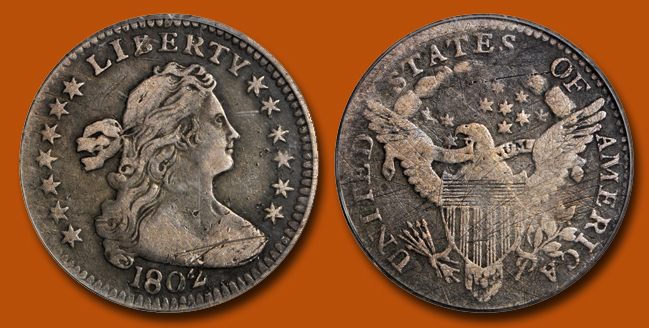
Well-known researcher and numismatist David J. Davis studied this issue extensively. With the assistance of numismatic organizations and other well-known numismatists, he concluded that no more than 35 distinct examples existed (published in his extensive listing of all known auction appearances in the 1999 reference Federal Half Dimes 1792 – 1837 by Russell J. Logan and John W. McCloskey). Since that time David Davis has passed away, but shortly before his death he told me he believed that perhaps as few as 25 distinct examples exist, as a few of those previous auction offerings were found to be counterfeits — or repaired and straightened coins previously listed as bent or damaged. Remarkably the 1802 half dimes in the National Numismatic Collection at the Smithsonian and the American Numismatic Association Museum are both coins of altered dates and thus not included in the census.
Much has been written about this particular issue. The first such research was conducted by leading numismatist of his era Harold P. Newlin, in 1883, when he published his work titled A Classification of the Early Half-Dimes of the United States soon after he sold his collection of half dimes through J.W. Haseltine on April 10, 1883. In that publication Newlin enumerated most of the known auction appearances — a total of 16. In 1931 Daniel W. Valentine published his work on the entire half dime series The United States Half Dimes in a pamphlet issued by the American Numismatic Society, later reprinted with additional notes by various numismatists in 1975. Valentine confirmed the rarity of the 1802 half dime but did not give a listing of individual specimens. In the 1975 Valentine reprint additional information on this date was provided by Walter Breen, and included a list of several known specimens. Currently the best reference on this particular date is the David J. Davis research published in Federal Half Dimes 1792-1837.
Comparable to the 1823 Capped Bust quarter in rarity, the 1802 half dime is indeed one of the rarest United States silver coins that actually circulated. The low mintage likely reflected the lack of demand in that particular year, as both the 1801 and 1803 half dimes are certainly far more plentiful by comparison. With the pursuit of these great rarities staying a major numismatic focus, it is likely that demand will simply keep rising.
Listed as #61 in the Jeff Garrett and Ron Guth 100 Greatest U.S. Coins reference, the 1802 half dime is highly desirable as it was not an unauthorized midnight project, but simply a low mintage date that served its intended purpose in the channels of commerce. Very little attention was paid for a few generations after these half dimes were struck, so survival was entirely random. Hence, the vast majority are well worn and many are damaged, unlike the present offering which is rather wholesome on balance. To date PCGS lists just 11 examples certified by that service, the finest is AU-55. Over the years 1802 half dimes have been available for a price; in more recent times the supply has pretty much dried up and offerings may be years apart. We are pleased to offer collectors the opportunity to take this desirable example home in our New York Americana Sale in February 2014.





